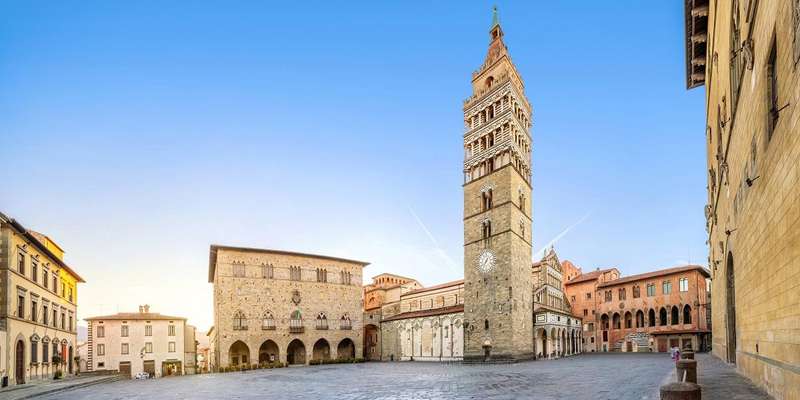- Home
- Useful Tips
- Pistoia's historic center
Most travelers speeding through Tuscany miss Pistoia's perfectly preserved medieval center, unaware they're bypassing one of Italy's most authentic experiences. Recent tourism data shows 83% of visitors cluster around Florence and Pisa, creating overcrowding while leaving nearby treasures like Pistoia pleasantly untouched. The frustration of fighting crowds when authentic Italy exists just off the beaten path is real - especially when you've invested time and money in your dream Tuscan holiday. Unlike its famous neighbors, Pistoia offers cobbled alleys where you can still hear Italian conversations echoing off 14th-century walls, family-run trattorias without tourist menus, and astonishing Romanesque churches where you won't elbow through crowds to admire the frescoes. This isn't just another pretty Italian town; it's living history without the performance, waiting for those who know where to look.


Navigating Pistoia's maze-like centro storico without wasting time
Pistoia's historic center unfolds like a medieval puzzle, where every arched alleyway seems to lead somewhere magical - if you know which turns to take. First-time visitors often spend hours circling the same piazzas, missing hidden courtyards and artisan workshops tucked behind unassuming doors. The key lies in understanding the city's radial layout, with Piazza del Duomo as its beating heart. From this central square, seven main streets branch outward like spokes, each leading to distinct neighborhoods. Locals suggest starting at the Cathedral of San Zeno, then moving clockwise to discover the octagonal Battistero di San Giovanni, the striking Ospedale del Ceppo with its colorful della Robbia ceramics, and finally the lesser-known Church of Sant'Andrea with its priceless pulpit. Remember, many streets change names every few blocks, so track landmarks rather than addresses.
Where to experience Pistoia's living traditions beyond the guidebooks
What truly sets Pistoia apart are the centuries-old traditions that still animate its stone streets. Every Wednesday and Saturday morning, the Piazza della Sala transforms into a market that's supplied the city since the Middle Ages, where fourth-generation vendors sell pecorino aged in nearby caves and hand-rolled pici pasta. Time your visit for July to witness the Giostra dell'Orso, a thrilling knight's tournament dating back to 1250, when armored horsemen charge at a bear-shaped target (now thankfully wooden). For a quieter local moment, visit the tiny bottegas around Via degli Orafi where artisans still craft jewelry using Etruscan techniques. The city's best-kept secret? The underground workshops near San Giovanni Fuorcivitas where restorers preserve medieval artworks - peek through their windows to see masters at work.
The truth about Pistoia's opening hours and how to plan accordingly
Nothing deflates a traveler's enthusiasm faster than arriving at a must-see site during Italy's infamous riposo (midday break). Pistoia follows its own rhythm, with most churches open 8am-12pm and 3-6pm except during mass, while museums often close Mondays. The silver lining? These quiet hours create perfect opportunities to explore lesser-known spots. When the Duomo closes its doors, duck into the nearby Palazzo dei Vescovi's underground Roman road, always accessible with a combined ticket. Smart visitors use 'closed' times to linger over a slow lunch at Fiaschetteria La Torre, where the owner handpicks wine bottles from his 15th-century cellar. Pro tip: The tourist office on Piazza del Duomo provides real-time updates on any unexpected schedule changes - their free map also marks all public drinking fountains with delicious mountain spring water.
How to see Pistoia's art treasures without the museum fatigue
Pistoia punches far above its weight in Renaissance art, but trying to absorb it all can leave you overwhelmed. Focus on three masterpieces: the dazzling silver altarpiece in San Zeno Cathedral (viewable by appointment), the 13th-century pulpit in Sant'Andrea that shows the birth of Italian sculpture, and the recently restored Della Robbia ceramics at Ospedale del Ceppo. Local art historians recommend the 'three glances' technique: First, observe the whole artwork from a distance. Next, move closer to study one compelling detail. Finally, circle the piece to discover how light transforms it - especially magical with Giovanni Pisano's pulpit sculptures. For a breather between masterworks, the hidden garden at Palazzo Buontalenti offers shady benches beneath lemon trees, where you can reflect on what you've seen while listening to the cathedral bells.
